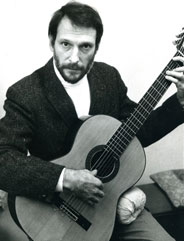About Stanley Watson > Letter from Stanley's Brother
A letter from Stanley’s brother, Richard, that I received in 2004 through the wonders of the internet.
Stanley and his sister arrived in England with their parents in 1930 and settled in Palmers Green, North London. Both his parents were musically inclined. His dad played the banjo and his mum had a good ear for music and was a fine singer. He was always musically talented and was playing on a ukulele of his dad’s at the age of three. He soon outgrew this and progressed to his father’s banjo, eventually taking up the guitar.
When he was about ten, he and his sister would go around the locality earning Christmas pocket money, usually ending up in a street called Broad Walk. This street was about a mile long and had red tiled pavements, was lined with trees and was the millionaire’s row of that part of London. They would be invited in to some of the big houses and asked to entertain, usually standing on the table in the centre of the room. They were sent on their way with gifts of food and money and did quite well when times were tough in the thirties.
At this time Stan and Gladys attended Arnos Grove School in North London. All the time Stan was listening to the sounds of jazz and big band music played on the radio, also buying jazz and classical records when he could. At about age 13 he met up with a young lad around the same age called Laurie Morgan. He heard Stan practicing behind the cricket pavilion in Arnos Park; they became great friends, and it was as a result of this meeting that Laurie took up drums and piano and went on to become one of the leading figures in the development of Be Bop in London in the 40’s and is still a respected figure to this day, playing up a storm every weekend as of this writing (‘04) at The Kings Head jazz club in Crouch End, London. At the age of 78, along with an another legend, Coleridge Goode, on double bass (87); they can still show the young Turks the way home.
As the 40s approached and WW2 was imminent, many of the children were evacuated to less dangerous areas. Stanley senior, being a conscientious objector, decided that the family would stay in London and take their chances, which they did and were bombed out twice in the course of the war. This reinforced Stan’s attitude on the futility of war and eventually led to him not registering for National Service at the age of 18, which was compulsory at the time.
When Stan was 15 he passed exams to go to Tottenham Technical School to study building and architecture His dad was hoping to have him enter the family business. This was not to be, however, as music got the upper hand. Stan and Laurie along with Don Rendell, tenor sax, another future giant of British jazz, and Denny Termer, later to be Shirley Bassey’s accompanist, all just about 16 years old, started in the business together playing in the pit band at Collins Music Hall in Islington, North London. Stan then went on to play in a band led by Duncan White who held a residency in one of the London hotels. Stan also was one of the first guitarists on the jazz scene in London to start playing amplified (electric) guitar. I believe that he had his own instrument, a big, black, wonderful Macaferi guitar modified for this purpose.
In the mid 40’s Stan became eligible for the call up which was then compulsory. He was a conscientious objector and managed to dodge the authorities for a couple of years until they finally caught up with him and promptly incarcerated him in a military mental hospital in Banstead, Surrey for six months, as they figured that he must be mental not to want to kill people instead of playing the guitar.
In the early 1950’s Stan was playing with E.N.S.A. as part of Marion McPartland’s group of musicians entertaining troops in Europe. This was what inspired Stan to expand his musical knowledge into other aspects of the guitar repertoire, as he felt restricted by the jazz format.
In 1954-5(?) he moved to Spain settling in Malaga. Stan became musical director to one of Spain’s top female singing artistes, as well as studying the guitar and traveling.
Stan came back to England in 1961 with his girlfriend, Diane, who eventually became his wife. Diane went back to America and Stan followed in 1966, settling in Rochester, NY.
Kindest Regards and respects,
Richard Watson.
Back to the Stanley Watson page
Home ::
Calendar ::
Listen & Watch ::
Recordings ::
Photo Galleries ::
Press ::
Bio ::
Workshops & Private Instruction ::
About Stanley Watson ::
Mad Scientist Guitar Projects ::
Contact & Booking ::
Photos & Posters for booking ::
Links
©Copyright 2007-2024, Kinoch Nelson, All Rights Reserved
Design by GCN, development by Red Beagle Web Development

In the early 1950's Stan was playing with E.N.S.A. as part of Marion McPartland’s group of musicians entertaining troops in Europe.
He and his sister…would be invited in to some of the big houses and asked to entertain, usually standing on the table in the centre of the room…














